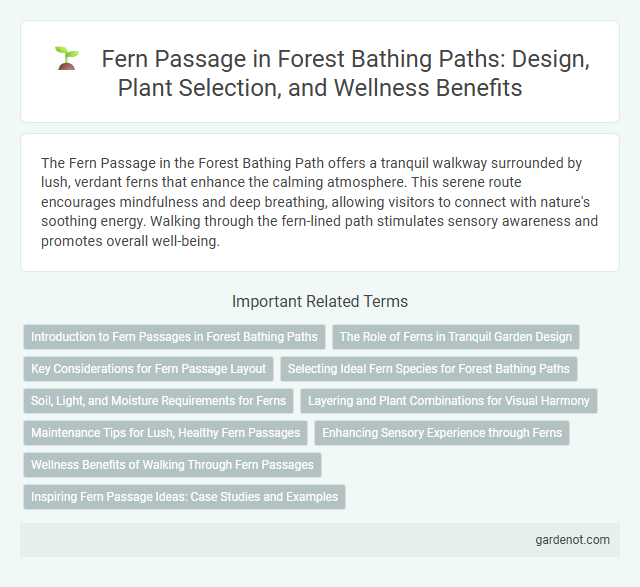The Fern Passage in the Forest Bathing Path offers a tranquil walkway surrounded by lush, verdant ferns that enhance the calming atmosphere. This serene route encourages mindfulness and deep breathing, allowing visitors to connect with nature's soothing energy. Walking through the fern-lined path stimulates sensory awareness and promotes overall well-being.
Introduction to Fern Passages in Forest Bathing Paths
Fern passages in forest bathing paths offer immersive experiences through lush fern groves, enhancing sensory connection with nature. These shaded corridors, rich in diverse fern species like maidenhair and sword ferns, create calming microclimates that support mental relaxation and stress reduction. Walking amid ferns facilitates mindfulness and deepens ecological appreciation, making Fern passages essential components of therapeutic forest bathing.
The Role of Ferns in Tranquil Garden Design
Ferns play a crucial role in tranquil garden design by creating lush, green textures that foster a sense of calm and natural beauty along the Forest Bathing Path. Their ability to thrive in shaded, moist environments enhances the serene atmosphere, making the Fern Passage a vital element for relaxation and mindfulness. Incorporating diverse fern species enriches biodiversity while softening the landscape with their delicate fronds, promoting deeper connection with nature.
Key Considerations for Fern Passage Layout
Designing the Fern Passage requires ensuring ample shade and moisture to support delicate fern species, with soil composition optimized for high organic content and proper drainage. Pathways should be gently winding and firm to prevent soil compaction while guiding visitors through lush fern clusters without disturbing root systems. Integrating native ferns and maintaining natural light filtering through canopy layers enhances biodiversity and the immersive forest bathing experience.
Selecting Ideal Fern Species for Forest Bathing Paths
Selecting ideal fern species for forest bathing paths involves prioritizing native varieties such as the Maidenhair Fern (Adiantum pedatum) and the Ostrich Fern (Matteuccia struthiopteris) due to their ecological compatibility and aesthetic appeal. These ferns thrive in shaded, moist environments, enhancing the tranquil ambiance critical for a restorative forest bathing experience. Incorporating diverse fern species with varying textures and heights can create a multilayered understory that enriches sensory engagement along the path.
Soil, Light, and Moisture Requirements for Ferns
Fern passage thrives in shaded to partially shaded forest floors where dappled sunlight filters through the canopy, creating ideal low-light conditions essential for fern growth. The soil must be rich in organic matter, well-drained, and consistently moist, providing the necessary nutrients and hydration that ferns require for optimal development. High humidity and stable moisture levels within this microenvironment support the delicate fronds, ensuring a lush and vibrant fern population along the forest bathing path.
Layering and Plant Combinations for Visual Harmony
Fern passage features carefully designed layering with diverse fern species such as lady ferns, cinnamon ferns, and maidenhair ferns, creating textured depth and lush greenery. Plant combinations include complementary shrubs like huckleberries and native wildflowers that enhance visual harmony and encourage biodiversity. This strategic layering supports ecological balance while offering serene, immersive forest bathing experiences.
Maintenance Tips for Lush, Healthy Fern Passages
Regular watering during dry spells ensures ferns remain vibrant and hydrated in the passage. Removing dead fronds and debris prevents disease and promotes airflow, essential for healthy growth. Applying organic mulch conserves moisture and enriches soil, supporting the lushness of fern passages throughout the year.
Enhancing Sensory Experience through Ferns
The Fern Passage in the forest bathing path maximizes sensory immersion by surrounding visitors with diverse fern species, each contributing unique textures and vibrant green hues that stimulate sight and touch. The subtle rustling of fern fronds in the breeze enhances auditory perception, promoting relaxation and mindfulness. This carefully curated fern environment deepens connection with nature, intensifying the overall forest bathing experience.
Wellness Benefits of Walking Through Fern Passages
Walking through fern passages enhances wellness by promoting relaxation and reducing stress through immersive natural surroundings rich in phytoncides and negative ions. The lush greenery of ferns aids in improving air quality and boosting respiratory health while encouraging mindful walking that supports mental clarity and emotional balance. Exposure to these shaded, tranquil paths stimulates the parasympathetic nervous system, fostering lowered blood pressure and increased overall well-being.
Inspiring Fern Passage Ideas: Case Studies and Examples
The Fern Passage exemplifies a successful forest bathing path by integrating diverse native fern species that enhance biodiversity and sensory engagement. Case studies highlight how the incorporation of naturalistic design elements, such as shaded walkways and moist microhabitats, promotes visitor relaxation and ecological education. Examples from temperate forest reserves demonstrate increased visitor satisfaction and ecological awareness through curated fern-themed trails and interpretive signage.
Fern passage Infographic

 gardenot.com
gardenot.com